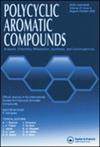揭示配体 M1069 与人血清白蛋白和 A2A 腺苷受体的结合相互作用机制--一种生物物理方法
IF 2.6
3区 化学
Q2 CHEMISTRY, ORGANIC
引用次数: 0
摘要
这项研究的重点是M1069,它是一种治疗实体瘤的有前途的药物,具有A2A腺苷受体拮抗剂的功能。在本研究中,我们通过采用...本文章由计算机程序翻译,如有差异,请以英文原文为准。
Insight into the Binding Interaction Mechanism of the Ligand M1069 with Human Serum Albumin and A2A Adenosine Receptor—A Biophysical Approach
The study focuses on M1069, a promising drug for solid tumors functioning as an A2A adenosine receptor antagonist. Herein, we investigate the binding mechanism of the drug molecule M1069 by employing computational techniques to draw comparisons with Human serum albumin (HSA), shedding light on the intricate interactions between M1069 and its target as well. The molecular docking results suggest that the drug molecule binds very well with the HSA protein when compared to A2AAR with the docking score of −7.02 kcal/mol. To substantiate the molecular interactions between the drug and the protein structure, comprehensive molecular dynamic simulations were performed for a period of 100 ns. This approach facilitated an in-depth analysis of the dynamic relationships and behaviors between the drug and the protein, offering valuable insights into their intermolecular dynamics and stability. Subsequently, DFT analysis is conducted to assess the inhibitory efficacy of the drug, employing the B3LYP technique. Additionally, an investigation into the pharmacological ADMET parameters of the drug molecule resulted in gastrointestinal absorption. These outcomes contribute to a better understanding of the interaction dynamics between the drug and the proteins, providing valuable insights that can enhance the drug discovery process.
求助全文
通过发布文献求助,成功后即可免费获取论文全文。
去求助
来源期刊

Polycyclic Aromatic Compounds
化学-有机化学
CiteScore
3.70
自引率
20.80%
发文量
412
审稿时长
3 months
期刊介绍:
The purpose of Polycyclic Aromatic Compounds is to provide an international and interdisciplinary forum for all aspects of research related to polycyclic aromatic compounds (PAC). Topics range from fundamental research in chemistry (including synthetic and theoretical chemistry) and physics (including astrophysics), as well as thermodynamics, spectroscopy, analytical methods, and biology to applied studies in environmental science, biochemistry, toxicology, and industry. Polycyclic Aromatic Compounds has an outstanding Editorial Board and offers a rapid and efficient peer review process, as well as a flexible open access policy.
 求助内容:
求助内容: 应助结果提醒方式:
应助结果提醒方式:


